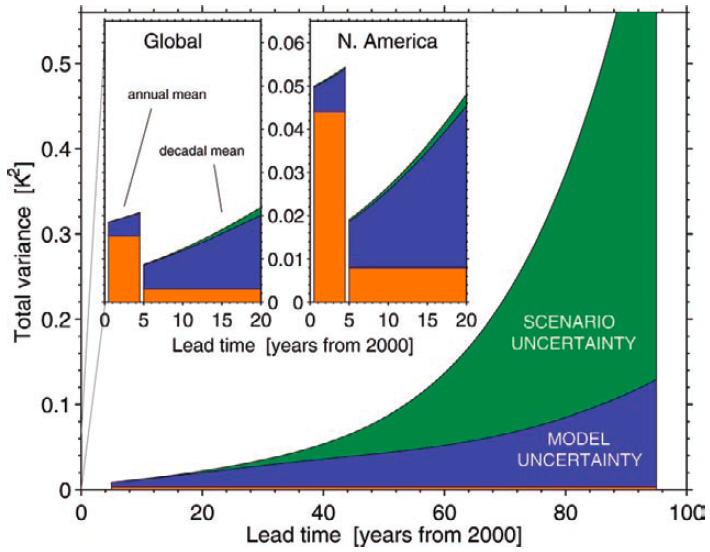Searching for a Suitable Successor
During November 2015, I was lucky enough to be in The Netherlands at Amsterdam International Water Week presenting a paper co-authored with my good friend and colleague, Enrique Lopezcalva. While we’re preparing the longer paper for publication, I thought a summary of our 15-minute presentation might be of interest here.
Our Thesis
Our thesis in this presentation is as follows: “Incorporating extreme uncertainty into water resources management and planning is an imperative for sound decision-making. Yet there are only a few established methods and tools for accomplishing that goal.” And in addition, there are many flawed methods that are inadvertently employed in our current practices – which I will explain.
Our thesis builds on a bold statement that appeared in the February 2008 issue of Science entitled, "Stationarity is Dead: Wither Water Management?” There the authors state that:
“In view of the magnitude and ubiquity of the hydroclimatic change apparently now under way . . . we assert that stationarity is dead and should no longer serve as a central, default assumption in water-resource risk assessment and planning. Finding a suitable successor is crucial for human adaptation to changing climate.”
Most practitioners have acknowledged and accepted the concluding assertion but few of us are able to do much about it.
Why is that? We are not well equipped to deal with the uncertainty that a lack of stationarity in climate and hydrology impose on our planning and analysis. In response to this challenge, our research and practice has been focused on three areas: (1) better understanding of the sources of uncertainty in the analysis of climate change and their implications for decision makers, (2) avoidance of inadvertent over-simplification of the nature of uncertainty and resulting translation of its implications into more traditional risk-based models, and (3) practical recommendations for practitioners who grapple with these issues.
Sources of Uncertainty
For the record I want to define my terms when describing “uncertainty” versus “risk.” These are definitions that go back to terminology introduced in 1920s by economist Frank Knight and adopted by the IPCC. “Risk" is applied to variables where a probability distribution can be defined reasonably well based on available data. “Uncertainty" is applied to variables where the data or theories do not exist to apply a reasonably defensible probability distribution.
I personally appreciate Michael Schwarz’s definition of extreme uncertainty where “There are no stationary trends, no data points close to the relevant values of a variable and no theory to guide the forecast. . . an environment approximating an information vacuum.” I think that this is reflective of our situation regarding climate change predictions. However, it might be better described as and “information blizzard with nearly zero visibility.”
Where does the uncertainty emerge? There are four primary sources: (1) various green house gas emissions scenarios, (2) many global climate models, (3) two different experimental calibration results known as the "Coupled Model Intercomparison Project (CMIP), and (4) the complexity and imprecision of downscaling climate models to reflect localized conditions.
So how does this affect what planners do? Here is a highly simplified representation of the traditional water infrastructure planning process. It begins with hydrological models based on long-tern stationary time series data offering reliable predictions of the frequency and severity of events. That information is fed into engineering evaluations of alternative system and operational solutions that can meet clearly defined level of service goals. Finally, decision-makers select among alternatives often using multivariate planning tools that frequently rely heavily on net present value analyses and decision-tree results based on expected outcomes. A deterministic approach relying largely on risk-based tools.
Our new reality requires extensive pre-analysis of the climate change implications on our hydrologic modeling. As I mentioned early, this introduces compounding uncertainty related to GHG emissions scenarios where there is no historical data or theory that can be used to credibly assign probabilities. Next, widely varying global climate models must be accounted for. And finally, given the scale of those global climate models (the entire planet) and a cell size that is significantly larger than the scale required to make decisions for local issues, downscaling is needed to adjust to the right resolution.
What do these steps contribute to the uncertainty we face? Ed Hawkins and Rowan Sutton have worked extensively on addressing the first two sources (emissions scenarios and modeling variability). This graphic illustrates three sources of variability in global predictions (1) natural fluctuations in climate without radiative forcing in orange, (2) model uncertainty in response to the same radiative forcing assumptions in blue, and (3) scenario uncertainty for different GHG emissions pathways in green. You can see that in long-lead time predictions the scenario uncertainties dominate the analysis. Interestingly, in short lead-time predictions and smaller scale predictions natural climate variation increases. Not easy to know what to do!
Recommendations
So here are some recommendations. First, what not to do is attempt to convert these fundamental sources of extreme uncertainty into probabilistic representations of risk, even though almost all of our down-stream tools expect the analysis to come in that form.
1. Make sure that extreme uncertainty is a fundamental consideration throughout the entire planning process
If the predicted effects of climate change have been reduced to a single probabilistic hydrologic forecast, then the most basic dilemma regarding how to deal with extreme uncertainty has been simplified out of the decision.
2. Ensure that decisions are robust and flexible under a wide range of possible scenarios
Two good examples of analytical approaches that do not rely upon predictive models are Info-Gap Decision Theory (IGDT) developed by Yakov Ben-Haim, and Robust Decision Theory (RDT) developed by the RAND corporation.
3. Define the minimum acceptable levels of service in addition to desired level of service goals
Establish the level of service below which the utility must never fall, identifying downside threats and measures to avoid them. Ensure consistency between local scenarios and GHG emissions scenarios used by IPCC. What are the outcomes that must not be allowed to occur?
4. Identify the greatest vulnerabilities associated with the resources plan, prepare for them, and protect against them
Address specific vulnerabilities that could result in unacceptable levels of service and proactively address those weaknesses in the capital investment and operational planning of the utility. Look for the places where you are vulnerable and do something about them.
5. Correctly value flexibility in the analysis of costs and benefits
Quantify real savings that result from the ability to rapidly expand or shed capacity, as well as quantifying the benefits associated with the timing of expenditures, and the resolution of some uncertainties over time (new technologies and extreme events). While rarely seen in capital investments plans for water infrastructure, place a monetary value on the flexibility needed to mitigate for vulnerabilities should they occur. There has been much talk about whether or not desalination facilities in Australia are/were wasted investments. On most days, life boats on a perfectly sound ship are wasted investments, but nobody questions their utility and value. It’s an appropriate response to extreme uncertainties and unacceptable outcomes.
6. Avoid decisions based exclusively on NPV methodologies and clearly distinguish between the predictable and uncertain elements of the decision
Many assumptions regarding construction costs, operational costs, financing costs, and other variables are likely very predictable. Forecasts of future hydrology and customer demands less so. Further, it is impossible not to answer decision-makers questions about the NPV of investments. Still, it’s essential to introduce the deeply flawed representation of risk that results when probabilities are assigned to plausible events for which the likelihood of occurrence cannot be predicted.
7. Incorporate real options and future flexibility in any investment plan and budget
Finally, be creative in the solutions that are identified. Large scale, centralized, single purpose, rigid, barrier-based solutions are an excellent response to highly predictable outcomes. Unfortunately, in water resources planning, highly predictable outcomes are a thing of the past. Find new approaches. Solutions that provide redundancy, are modular, have rapid response times, distributed functionality, and offer increased levels of immunity to the hydrologic cycle (something water recycling and ocean desalination facilities do). Remember, proactive investments to increase preparedness and flexibility must be proposed before they can be evaluated. Don’t leave them out as alternatives.
Conclusions
What does this mean for planners, engineers, and policy makers? As planners, we should carefully deconstruct the decision-making tools we employ and evaluate how dependent they are on risk-based comparisons like net present values, decision-tree outcomes, and discount rate assumptions. Just as important is the development of tools that assess the value of flexibility — as opposed the the value of certainty.
As engineers, we should be sure that the solution set we bring to problem solving includes options that allow for flexibility and adaptation over time.
And as policy makers, we should support investments in options that increase preparedness, reduce response times, and track real needs as they are better understood over time. And finally, we should increase our investment in science and research to accelerate our understanding of climate change and inform appropriate responses.





